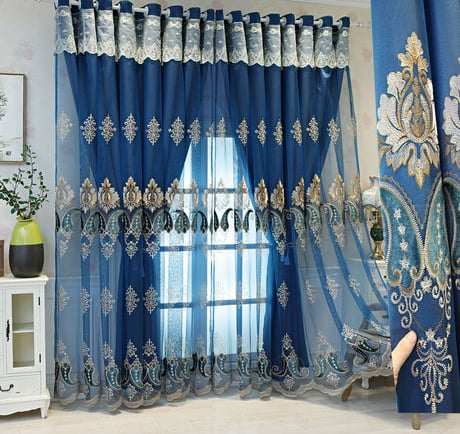The Art of Pattern Mixing: Creating Dynamic Curtain Styles with Bold Prints and Textures
11/28/20244 min read


Understanding Pattern Mixing
Pattern mixing is an essential concept in interior design that involves combining various patterns to create visually engaging and dynamic environments. By interweaving different motifs, designers can infuse spaces with energy and personality. The art of mixing patterns extends beyond mere aesthetics; it allows for the expression of individual style and can significantly enhance the emotional atmosphere of a room.
To successfully implement pattern mixing, one must consider a few fundamental principles. First and foremost is the importance of balance. When incorporating multiple patterns, attention should be paid to color coordination, scale, and shape. Complementary colors can enhance the harmony of different prints, while disparate shapes contribute to visual interest. A typical rule of thumb is to mix a dominant pattern with two or three secondary ones. This approach helps maintain cohesion while providing variety and depth.
Furthermore, it is crucial to consider pattern scale. Combining patterns of varying sizes can create an intriguing visual dialogue. For example, pairing a bold, large-scale print with smaller, more intricate designs fosters a layered effect that is both appealing and sophisticated. When done right, this interplay not only elevates the design but also draws the eye across the space, creating a flow that is pleasant to the viewer.
The emotional impact of mixing bold prints and textures cannot be overstated. Carefully curated combinations can transform a mundane environment into an inviting haven. Patterns evoke feelings and memories, so strategically incorporating diverse designs can provoke specific reactions. Ultimately, the practice of pattern mixing can breathe life into any room, allowing it to tell a unique story and reflect the personality of its inhabitants.
Choosing the Right Patterns and Textures
The selection of patterns and textures is crucial for creating coherent and visually appealing spaces, especially when it comes to curtain styles. To begin with, understanding the variety of available prints can significantly enhance your interior design. Floral patterns evoke a sense of nature and freshness, making them suitable for soft and inviting atmospheres. Geometric prints, on the other hand, are ideal for contemporary settings as they add a structured and modern touch. Abstract patterns offer flexibility, as they can blend seamlessly with a wide range of styles, providing an artistic flair.
When mixing these prints, it’s essential to consider how they interact with one another. A general rule is to choose patterns that differ in scale. For instance, a large floral print can be paired effectively with smaller geometric shapes. This contrast draws the eye and creates an engaging visual effect while maintaining equilibrium. Additionally, introducing textures into the mix can elevate the design further. Fabrics such as linen, velvet, and silk each come with distinct properties that can add depth to your curtain styles.
Color coordination plays a pivotal role as well. Picking a cohesive color palette ensures that the overall look is harmonious. You might choose complementary colors to create a vibrant atmosphere, or opt for analogous colors for a more subtle, calming effect. Another approach is to select a dominant pattern that serves as a focal point in the room. This pattern could be the largest curtain panel, which then dictates the choice of secondary fabrics that enhance but do not overwhelm it.
By considering the interplay of patterns and textures along with thoughtful color coordination, designers can create dynamic curtain styles that not only stand out but also work together to establish a unified aesthetic.
Practical Tips for Mixing Patterns in Curtains
Mixing patterns in curtain styles can transform a space, but achieving the perfect blend requires thoughtful consideration. One essential tip is to start by selecting a color palette. Choose a few complementary colors that can act as a common thread among the various prints. This cohesive color scheme helps to unify the different patterns, making them appear harmonious rather than chaotic.
When layering patterns, consider varying the scale of the prints. Combining a large floral print with a smaller geometric design can create visual interest while ensuring that the patterns do not compete with each other. For instance, large motifs can serve as a statement piece, while smaller patterns can enhance the overall design without overwhelming the space. This scaling technique works effectively in spaces where you want to create a dynamic yet balanced aesthetic.
Another practical approach is to choose different types of curtains. Combining sheer curtains with heavier drapes allows for effective pattern mixing while maintaining functionality. Sheer curtains can soften bold prints, providing a gentle contrast to denser patterns. Additionally, blending materials, such as linen and cotton, can enhance textural variety, contributing to the overall ambiance of the room.
Proportions play a critical role in successful pattern mixing. Always assess the size of your room and the placement of your curtains. Patterns should accentuate the room’s features rather than dominate them. For smaller rooms, consider using a single patterned curtain type, whereas larger spaces might benefit from an eclectic mix of styles. Real-life examples can be drawn from interior design showcases where combinations of vibrant prints and textures evoke a sense of dynamism and style. By following these guidelines, one can confidently experiment with bold prints to craft captivating curtain styles.
Caring for Your Boldly Patterned Curtains
Caring for boldly patterned curtains is essential to maintaining their vibrant appearance and overall longevity. The specific fabric and print of the curtains will significantly determine the best cleaning methods to employ. For instance, cotton and polyester fabrics are generally machine washable, while delicate materials like silk or velvet may require gentle hand washing or professional cleaning to avoid damage.
Before washing, it is wise to check the care label for specific instructions. For machine-washable curtains, using a gentle cycle with cold water is advisable. Avoid using bleach, as this can lead to fading and discoloration of the bold patterns. Instead, consider using a mild detergent that is color-safe and designed for vibrant fabrics. Additionally, it is beneficial to wash curtains separately from other items to prevent snagging or tangling.
When drying your boldly patterned curtains, air drying is preferred to avoid any shrinkage or warping. If using a dryer, the low heat setting is recommended. Upon removal, give them a good shake to minimize wrinkles, and avoid hanging them directly in bright sunlight to prevent the vivid colors from fading over time.
Storage also plays a crucial role in maintaining the integrity of your curtains. When not in use, ensure that they are clean, dry, and folded neatly to prevent creases. Using breathable fabric bags can help in keeping dust at bay, while avoiding plastic storage solutions that may trap moisture and encourage mildew.
As seasons change, experimenting with switching curtain styles can breathe new life into your décor. Transitioning between different patterned curtains while following the care guidelines will ensure they remain a stunning focal point in your rooms for years to come. By adhering to these maintenance tips, you can preserve the vibrancy and texture of your bold prints, creating an enduring and dynamic atmosphere in your home.
Curtains&Fabrics
Design,production,sales,service in curtain fabrics&curtians.
Quality
Products
sales01@anytextile.com
+8615968501933
© 2024. SHAOXING LEYAO IMPORT AND EXPORT CO.LTD All rights reserved.
